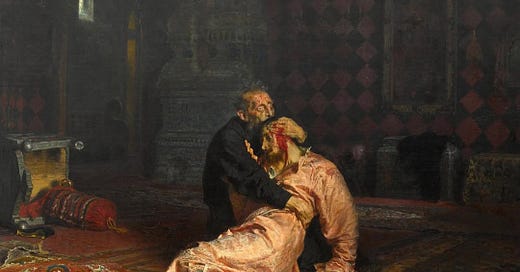ILYA REPIN - IVAN THE TERRIBLE AND HIS SON IVAN, 1885
The painting depicts a tragic historical moment from November 16, 1581, when Tsar Ivan IV (Ivan the Terrible) fatally struck his eldest son, Tsarevich Ivan Ivanovich, in a fit of rage. The artwork captures the immediate aftermath: Ivan’s face is contorted with anguish and regret, his eyes wide with shock, as he holds his son’s limp body. The Tsarevich, shedding a tear, lies pale and lifeless with blood trickling from his temple—the irreversible consequence of the Tsar’s uncontrolled temper. Repin’s work is not just a historical depiction but a powerful commentary on guilt, power, and the devastating effects of unchecked emotions.
The historical accounts surrounding this moment, are debated and rely heavily on foreign testimonies. According to Antonio Possevino, a Jesuit envoy present in Moscow during the early 1580s, the altercation arose from a heated argument between Ivan and his son. The dispute was personal, centered on Ivan’s disapproval of Tsarevich Ivan’s wife, Yelena Sheremeteva. Possevino claimed Ivan struck Yelena for dressing immodestly, and when the Tsarevich intervened to defend her, Ivan, in a fit of rage, struck his son with a pointed staff, fatally wounding him in the head. Another account, from foreign sources like Polish and German diplomats, points to political tensions as a contributing factor. Tsarevich Ivan, as heir to the throne, reportedly clashed with his father over military decisions, particularly Russia’s faltering Livonian War.
The painting’s controversy arises from its bold depiction of a revered yet notorious historical figure and its implicit critique of autocracy. Upon its unveiling, it shocked audiences and authorities alike for portraying Ivan not as a heroic Tsar but as a guilt-ridden, almost pathetic figure responsible for his son’s death. This humanization of Ivan challenged the glorified narratives of Russian rulers, prompting accusations that the painting was subversive. In 1885, Tsarist authorities briefly banned its public display, fearing it could incite anti-autocratic sentiment, especially amid growing social unrest in the late 19th century. Even in modern times, the painting has faced scrutiny; for instance, in 2018, it was vandalized by a man who believed it misrepresented history, highlighting its enduring ability to provoke.




